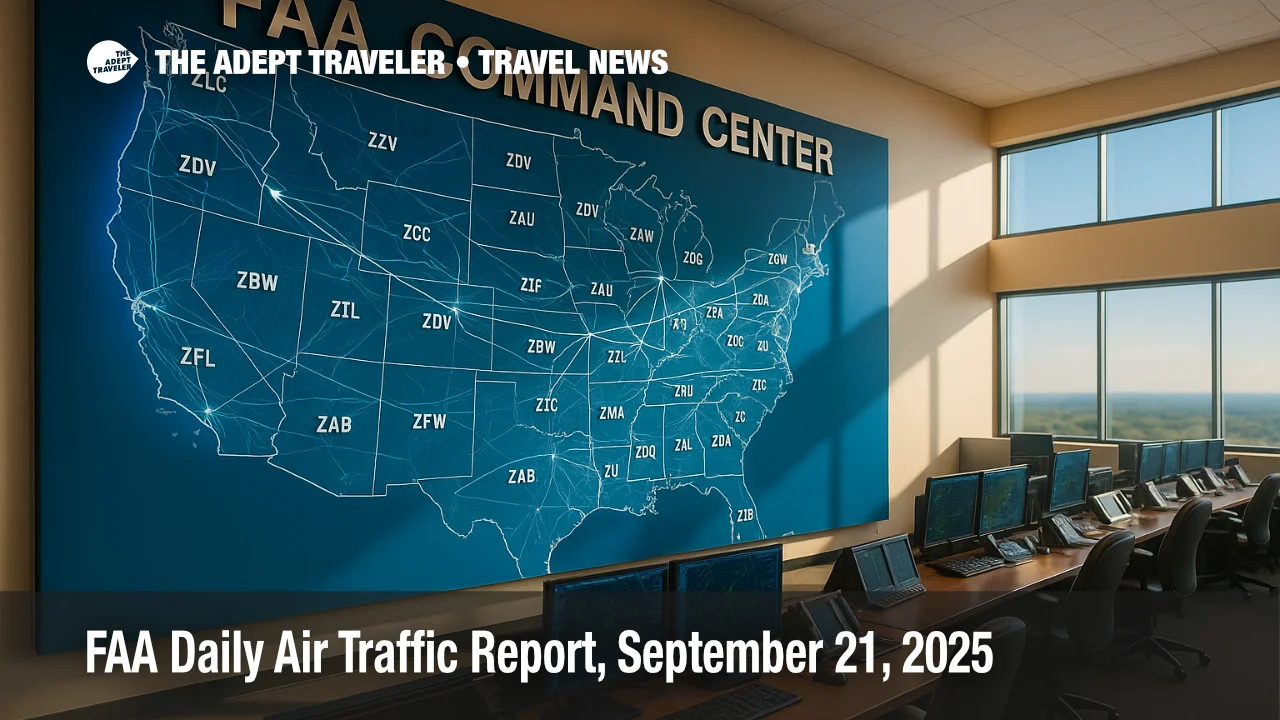FAA Daily Air Traffic Report, September 21, 2025

Thunderstorms over multiple centers, a Ground Delay Program at Boston Logan International Airport (BOS), and required reroutes toward Chicago are shaping today's U.S. airspace picture. The ATCSCC operations plan flags possible ground stops or delay programs at O'Hare, National, San Francisco, Dallas, Houston, Miami, Minneapolis, and Denver as the day evolves. A severe-weather hotline is active, and a Florida rocket launch window is driving morning coastal and oceanic route management.
Key Points
- Why it matters: Targeted GDPs, reroutes, and convective weather could ripple across hub connections and peak bank times.
- Travel impact: BOS running a GDP, ORD flows constrained via Lake Erie West reroutes, with additional GS or GDP risk at DCA, SFO, DFW, and others.
- What's next: Afternoon to evening risks increase for BOS, SFO, IAH, MIA, MSP, and DEN per the plan timeline, subject to updates at the planning webinars.
- SpaceX launch windows and oceanic route closures influence Florida and Atlantic traffic early in the day.
- Europe's MUSE check-in disruption continues at Heathrow, Brussels, and Berlin, which can add knock-on delays to transatlantic flows.
Snapshot
Active now: BOS GDP. MDW is posting minor general delays. Reroutes: An ATCSCC FCA is directing Lake Erie West traffic flows into Chicago, part of today's mitigation for Midwest weather. Risk windows: After late morning and through the evening, plan for potential GS or GDP at Chicago O'Hare International Airport (ORD), Chicago Midway International Airport (MDW), Ronald Reagan Washington National Airport (DCA), San Francisco International Airport (SFO), Dallas Fort Worth International Airport (DFW), Dallas Love Field (DAL), George Bush Intercontinental Airport (IAH), William P. Hobby Airport (HOU), Miami International Airport (MIA), Minneapolis-Saint Paul International Airport (MSP), and Denver International Airport (DEN). Hotline: Severe-weather issue-resolution page is active.
Background
The Air Traffic Control System Command Center manages demand and constraints using tools like Ground Delay Programs, Ground Stops, and Airspace Flow Programs. Today's operations plan cites thunderstorms across numerous centers, low ceilings in the Washington area, and oceanic route restrictions, with Florida space operations adding periods of coastal and offshore closures. Expect evolving FCA reroutes, CDRs, and SWAP actions as storms and traffic peaks develop, and watch for updated advisories at scheduled planning webinars.
Latest Developments
BOS GDP active, ORD routing constraints via Lake Erie West
Boston is under a Ground Delay Program, while Chicago arrivals are being shaped by a "Lake Erie West to ORD" FCA requirement in effect through the daytime push. Midway shows only light gate-hold and taxi delays at this hour, but the plan carries late-morning potential for ground stops or a delay program across the Chicago metro depending on thunderstorm timing and routing efficiency.
DCA low ceilings and flyover window, East Coast oceanic constraints
Low ceilings around Washington could prompt a GS or GDP at DCA, and there is a scheduled flyover window from 1045 a.m. to 1203 p.m. CT that can briefly add sequencing complexity. New York oceanic routes may see closures at times, which can affect transatlantic departure profiles, connections, and ETEs along the corridor.
SpaceX launch, Florida Y-route limits, and Gulf closures
A SpaceX Falcon 9 launch window out of Florida drives morning-period restrictions, including "no AR, Atlantic Y-routes to MCO, TPA, RSW areas" and a CAPE LAUNCH partial. Gulf and Atlantic route closures are possible later, with Houston and Miami both carrying afternoon potential for CDRs, SWAP, or GDP depending on convective trends.
Analysis
Today's NAS risk is a balancing act between scattered convection, metro-hub peaks, and special-use constraints. The BOS GDP moderates arrivals into a runway and wind-sensitive field, while the Lake Erie West FCA helps stabilize merge points and final approach spacing into ORD during Midwest storms. If New York oceanic routes close intermittently, longer transatlantic routings and revised departure slots can propagate delay minutes into evening banks. Florida's spaceflight window adds a separate, time-bounded squeeze on coastal and offshore routes. Operationally, these layered constraints reduce flexibility when pop-up storms force tactical reroutes, so schedule buffers and misconnect risk are elevated in the late-day period at SFO, IAH, MIA, MSP, and DEN, with Dallas watching both weather and residual network sensitivity after Friday's telecom outages were resolved.
Final Thoughts
Travelers should enable airline push alerts, watch EDCT updates, and build extra connection time at BOS and ORD. For Washington-area itineraries, low ceilings and a late-morning flyover can briefly compress capacity, so earlier departures or longer buffers can help. If you are crossing the Atlantic, allow for longer taxi-out, potential reroutes, and sporadic delay minutes while European check-in systems stabilize. Keep carry-on essentials with you, and print or download boarding passes in advance. We will keep monitoring advisories and programs as they evolve in today's FAA daily air traffic report.
Sources
- Most recent ATCSCC advisory, FAA
- ATCSCC Current Operations Plan, FAA
- Current reroutes, FAA
- National Airport Status, text version, FAA
- Dallas airports return to normal after outage, Reuters
- European airports disruption continues after MUSE cyber incident, Reuters
- Heathrow, Brussels, Berlin delays persist Sunday, The Guardian
- Europe air travel snarls continue Sunday, Bloomberg
